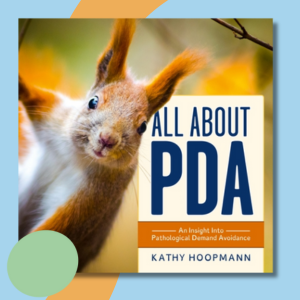Book - All About PDA by Kathy Hoopmann
Book - All About PDA by Kathy Hoopmann
Couldn't load pickup availability
- Same day shipping available for orders placed before 1pm Mon-Fri
- Express Shipping Available
- Flat Rate Shipping $12 Australia Wide *Excludes heavy or bulky items
Through engaging text and full-colour photographs, this book shows how PDAers see and experience the world and highlights the unique characteristics that make them special. A perfect introduction to PDA for those recently diagnosed, as well as their families, friends, and the people who work with them!
A beautifully compassionate introduction to Pathological Demand Avoidance, All About PDA uses full-colour, animal-themed photographic storytelling to illustrate how PDA-ers experience the world. With gentle humour and clarity, it demystifies a complex profile—helping children with PDA to feel seen and understood, offering families, educators, and therapists essential insight and hope. An affirming, strength-based resource perfect for home, classroom, or counselling spaces.
Why You’ll Love This Book
- Clear, compassionate explanation of Pathological Demand Avoidance (PDA).
- Uses humor and vibrant animal photography to make learning engaging.
- Strength-based approach helps children feel understood and valued.
- Opens up conversations between families, teachers, and therapists.
- Practical insights that reduce stigma and increase empathy.
Who This Book Is For
- Parents supporting children with PDA.
- Teachers wanting to better understand PDA students.
- Therapists and psychologists building a neurodiverse library.
- Children who want to see their experiences represented.
Click here to view other Kathy Hoopmann books.
From the author Kathy Hoopmann:
When I considered writing a book on Pathological Demand Avoidance (PDA), my first thought was, ‘Is there a need for it?’ To find out, I approached the experts – PDAers themselves -and I was resoundingly told, ‘Yes! We need others to know about us, to understand us and realise we are not trying to be difficult. Please write this book.’ Likewise, when I approached those who lived and worked with PDAers,they said, ‘We want people to know that PDAers are amazing people who help us reevaluate our philosophies and approaches to life and may well be the catalyst for systemic change to education and welfare that benefits all. Please write this book!’
So, I wrote this book.
PDA, first identified by psychologist Elizabeth Newson in the 1980s, is a diagnosis in progress. PDAers exhibit an extreme resistance to, or avoidance of, the everyday demands of life, even activities they may enjoy, based on a need to feel in control when anxious or stressed. It is not recognised on the DSM 5 and various specialists have different views about what it is and how it plays out in life. There is a consensus that it is a profile of autism, and it certainly shows up mostly under the autistic umbrella. However, some researchers suggest that there are PDA links to ADHD and other diagnoses as well, and some believe it is a stand-alone condition. Likewise, the language around PDA is constantly adapting and changing. Even the term ‘Pathological Demand Avoidance’ has its nay-sayers, with alternative preferences including Pervasive Drive for Autonomy, Persistent Drive for Autonomy, Pervasive Demand Avoidance or Extreme Demand Avoidance among others. Currently, the term Pathological Demand Avoidance is used for the sake of continuity and clarity, although that may change in the future. So, when I wrote this book, I had to take all that into consideration.
I have to admit that this is one of the hardest books I have ever written. I lost track of the number of edits it took to get the language right. The last page alone went through numerous changes. I could not have written this book alone. I am very grateful to those in the PDA community who gave me enormous amounts of their time, wisdom and story-sharing. Special thanks goes to Heidi Brandis (Founder of PDA Perth WA Parent Community and Support Group) and Sally Canadine (PDA Talk) who patiently spent hours and hours helping me fine-tune the language and correct the grammar and who were not afraid to tell me when I got things wrong. I pray that the result is a book in which PDAers can see themselves affirmed on the page and through which their parents and carers and siblings and friends and teachers can find understanding and hope. And hopefully, all can come away with a smile and the knowledge that things can get better.
Share




